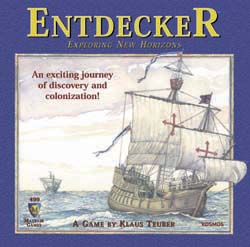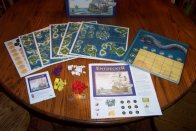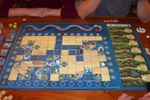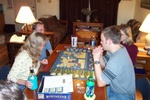
|
Entdecker - Exploring New Horizons A game by Klaus Teuber Published by Mayfair Games, Inc. and Kosmos Players: 2 to 4 Time: 90 minutes Reviewed by Susan Rozmiarek |

|
With the flood of quality games released each year, it is all too easy to become distracted by the shiny new stuff while older gems languish unplayed on the shelves. Entdecker, a tile-laying exploration game, is such a gem. I always enjoy pulling out a favorite that is a few years old and seeing if it still shines when held up to the latest and greatest games of the moment.
The original Entdecker was published by Kosmos in 1996. The initial reaction seemed to be one of disappointment, but some speculated that this was due to the fact that it followed on the heels of Klaus Teuber's very popular Settlers of Catan and thus suffered from inflated expectations. Fortunately, the game was given a new chance in 2001, after being given a makeover and revamping. The result is Die Neuen Entdecker from Kosmos which was subsequently published in an English edition, Entdecker - Exploring New Horizons from Mayfair Games. I have not played the older, out-of-print edition and therefore cannot comment on the changes and additions to the game. They have been discussed quite thoroughly elsewhere and my impression is that the changes have been generally well received. This review will focus solely on the newer and readily available edition.
Components:
The quality of the components is very good overall. The Kosmos and Mayfair editions are virtually identical except for the box art and of course, German rules from Kosmos versus English rules from Mayfair. The actual game components have no text and are thus language neutral.The board is simply enormous, 33'' X 22'' with a striking scoring track across the top in the form of a sea serpent. The 180 discovery tiles are sturdy enough, but could be thicker. The same goes for the gold coins and produce tokens. The art on the board and tiles is quite attractive. In addition, a set of colored wooden units is provided for each player and there is a rather nice wooden explorer's ship. A cloth bag is provided for the produce tokens.
My only real quibble is with the native huts. These are in two parts which are assembled by putting tabs into slots with the produce tokens sandwiched and hidden in between. They are rather clumsy and awkward to handle. Just having a picture of a hut on the back of the tokens and placing them on the board face down would have been simpler. We also found it easier to randomly place the tokens in the huts before the game. It seems unnecessary to draw them separately during the game.
The rules are well-written and contain numerous illustrations and examples in full color. In addition, there is a Professor Easy pamphlet that explains the game by showing a sample game.
All of these components fit neatly in compartments of a plastic insert in the box.
Game play: The object of the game is to earn the most Discovery Points by discovering islands and rare, exotic plants. Players earn points by financing and taking discovery trips into unexplored regions of the board and establishing themselves on the islands they find. They achieve this by laying tiles that depict land and/or sea. As the game progresses and islands are fully explored, they are able to send scouts on expeditions for valuable plants represented by a series of jungle paths on the right side of the board.
Setup:
Each player starts with 7 gold pieces, 2 forts, 1 settlement and 12-20 scouts, depending on the number of players.
A native hut is placed at the end of each jungle path.
Discovery tiles are sorted by their backs into six face down stacks and seven face up stacks.
The board is set up as illustrated in the rules, with island tiles containing bonuses and some
sea tiles placed on the designated spots.
There are some additional setup scenarios in the back of the rules that encourage different exploration strategies.
The variable setup options greatly increase the replayability of the game.
Mechanics and comments:
A start player is chosen and play begins.
There are several phases to each player's turn before play passes to the next player.
The phases are:
- Roll for income:
If a player has fewer than four gold pieces, he rolls the die and ALL players get income.
The active player gets the amount (2-6) rolled and all other players get the amount PLUS one.
If the wheel pictured on one side of the die is rolled, the active player gets to choose the amount (2-6).
This is a rather odd mechanism but it definitely adds some spice to the money management aspect of the game. You don't want to be the one always rolling the dice and giving everyone more money than you get, so you must consider this as you plan your expenditures. You often have to almost skip a turn and hardly spend anything to get out of that cycle. I have, however, won a game while being the primary die-roller.
- Select the starting spot for your trip:
This will be on the edge of the board or a previously laid tile (discovered area) on the board.
If you do choose a tile, you must be able to trace a path via the white lines on the tiles back to a spot on the edge of the board.
- Pay starting expenses:
Some starting spaces around the board cost a fee and if your route traces back to only an edge
space with a fee you must pay it.
In addition, if the route you trace back passes by any player's fort or settlement, you must pay him a toll.
I found that very few tolls were paid in our games. They do provide a minor annoyance by blocking a good route. Most players, including myself, would rather come in at a different starting point with a fee than pay another player a toll. As the board gets more explored, starting spaces and tolls become less of an issue as it becomes easier to trace a path back to a free starting space while circumventing other players' forts and settlements to avoid the toll.
- Explore:
This is the heart of the game and is where the theme really shines through.
You place your ship on the chosen starting spot and declare how many tiles you will
be drawing and whether or not they will come from the face-up or the face-down stacks.
The key points are that you can never draw more than you declare,
they must come from one type of stack or the other, not both,
with tiles from the open stacks being much more expensive,
costing four coins each versus one each for tiles from the hidden stacks.
You then pay the cost for ALL the tiles you declared.
Then you start drawing and placing them.
They must be placed in such a manner that they are adjacent to the tile spot on
which the ship sits and the adjacent edges (land or sea) match.
If a tile cannot be placed, it is discarded and you do not get a refund.
After each placement, the ship is moved onto the newly discovered tile.
You may stop at any time you choose or you can decide to place a unit on the new tile in which case you must stop.
This is the part of the game which provides the most interesting decisions. You must carefully consider how much gold you have to spend versus what you want to accomplish. You need to make sure you save enough money to purchase the unit you want to place after laying tiles. The fact that you have to pay for the number of tiles you declare up front, whether or not you end up playing them, is particularly painful. If you are drawing from the hidden stacks, the more you declare and pay for, the better your chances of getting a tile that is useful to you. If you really need a particular tile, it is often worthwhile to pay the high cost of getting one from the open stack. In this way, you can mitigate some of the luck in the game. However, with money being tight, it is always tempting to gamble and pay less and take your chances with the hidden stacks.
Some of the tiles in the hidden stacks have a question mark on their backs and they trigger an event when placed, adding some additional risks. Some of the events are good and some are bad. By keeping track of which event tiles have already been placed, one can decide whether or not it is worth taking the risk and choosing a tile with a question mark. Gold mines and friendly natives can earn additional income or the placement of a free scout, while storms and pirates can end your turn or take away some of your gold.
- Placing a unit:
You may decide to end your voyage and place a fort, settlement or scout on a land mass.
This can only be done on the tile just explored (placed).
You pay the cost and place one unit.
Settlements cost more than forts which cost more than scouts.
These units will remain there until the island scores at which time they will go back to you to use again.
The only exception are the scouts.
These may be removed from elsewhere on the board if you have no more in your supply.
Care must be chosen where these units are placed because they are very limited and aren't returned to you until the island is completed. In this, Entdecker feels similar to the game Carcassonne.
- Filling in surrounded unexplored areas:
If a single unexplored space on the board becomes completely surrounded by explored areas,
tiles or edge spaces, then that area is filled with a tile from the open stacks.
Similarly, if an unexplored area (can be more than a single space) is completely surrounded by
land then it is filled in with land-only tiles.
This not only keeps the game from dragging, it provides some interesting tactical options. With clever placements, you may be able to cause an island to be filled in and completed by the cost of placing one tile, perhaps even stealing the Main Explorer majority from another player by placing a unit on the played tile.
- Score completed islands:
At the end of each player's turn, any completed islands are scored.
The value of the island is equal to the number of tiles plus any bonuses.
The Main Discoverer is awarded points equal to that value.
The Main Discoverer is determined by counting the number of settlements, forts and scouts on the island.
Settlements are worth more than forts which are worth more than scouts.
The player with the most valuable unit on the island is the Main Discoverer and
gets points equal to the full value of the island.
The second place player gets half the value, the third a fourth, and the fourth place player,
if present, gets an eighth of the value in points.
All units are returned to the players except scouts.
Scouts that were present on the scored island are placed by players on the jungle paths.
This is a typical struggle for area majorities that is seen in many games. What is nice in this game and different than most is that all players with a presence on an island will score something. As with most majority struggles, not getting greedy and accepting second or third places on many islands can often get a player more points than concentrating too much effort on first places on a few islands. Of course, this does not really apply in the two player game, where competition for islands is a head-to-head battle for first, and for this reason I like the three and four player games better.
- Placing scouts on jungle paths: When an island is completed and scored, players, in turn order, place their scouts that were on the island, one at a time, on the first available spot on the jungle path of their choice. If the scout is placed on the first spot of the path, the player draws a treasure token out of the bag, looks at its value, and places it in the hut at the end of that path so that it is hidden. If a player places a scout on a spot with an eye, he may look at the token hidden in the hut on that path. At the end if the game, the huts will be scored. The player with the most scouts on each path will get discovery points equal to the value of the token (5, 10, or 15) hidden in the hut. Ties are broken by the scout closest to the hut which can be key to winning the majority.
The game ends when all undiscovered areas on the board have been filled with tiles. The Jungle Paths are scored and the winner is the player with the most discovery points.
Summary:
There are several good exploration games available, and Entdecker holds its own amongst the best of them, in my opinion. While theme is usually not very important to me in most types of games, an exploration game is one of the few types in which I do expect the game to capture some of the feel of its theme and in this Entdecker succeeds. It's quite fun to watch the board develop.
The game starts rather slowly and builds, getting much more interesting and exciting in the latter half. The game is a little on the longer side, taking about 90-120 minutes. Downtime is minimal, though, and I usually do not find myself bored. Rolls for income and island scoring that affect you directly on other players' turns keep your interest as well as just watching the board develop.
The game is not light, but neither is it too heavy for more casual or older family gamers. It has plenty of interesting decisions while maintaining a element of luck, befitting attributes for an exploration game. Player interaction is of the indirect kind, mostly through majority struggles. It works very well with two, three or four players, although I like it better with more due to the increased competition for islands. While a few of its mechanisms seem awkward at times, they add more tension and decisions to the game and it would be less interesting without them. Those who enjoy tile-laying games as well as area majority games should enjoy Entdecker quite a bit.
Fans of exploration games have several good titles from which to choose. Entdecker is both unique and enjoyable, making it a worthy addition to the genre.
Other Web information:
This page viewed
E-mail Ed Rozmiarek with questions or problems concerning this page.
Copyright © 2003, Ed Rozmiarek



